|
|
|
Sort Order |
|
|
|
Items / Page
|
|
|
|
|
|
|
| Srl | Item |
| 1 |
ID:
122684
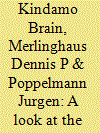

|
|
|
|
|
| Publication |
2012.
|
| Summary/Abstract |
The role of USA in modern warfare has rapidly changed over the pats few years. Armed forces would wide are beginning to explore the possibilities offered by unmanned vehicles (UV) especially with respect to both sensors and weapons. The operational capabilities of UV are now demonstrated in accordance with the capability profiles. It should be noted that regardless in whatever capability category a UAS is used, a commander is always required to judge mission success under the aspect of mission accomplishment and survivability. UAS are not yet to be regarded as one way systems.
|
|
|
|
|
|
|
|
|
|
|
|
|
|
|
|
| 2 |
ID:
122673
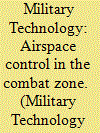

|
|
|
|
|
| Publication |
2012.
|
| Summary/Abstract |
The airspace of the combat zone is a crucial part of the battlespace and is used by all components of the joint and multinational forces. A high con- centration of friendly surface, sub- surface, and air-launched weaponsystems must share this airspace without unnecessarily hindering the application of combat power.
The primary goal of combat zone airspace control is to enhance the combat effectiveness of the joint force. Airspace control includes coordinating, integrating, and regulating airspace to increase
operational effectiveness
|
|
|
|
|
|
|
|
|
|
|
|
|
|
|
|
| 3 |
ID:
130151


|
|
|
|
|
| Publication |
2013.
|
| Summary/Abstract |
Airborne Electronic Warfare (EW) encompasses several different tasks: It includes the tactical detection
of Radio Frequency (RF) energy emitted by ground-based, aircraft-mounted and weapons guidance radars, and the activation of active and passive counter - measures to neutralise such threats. Beyond its tactical use, EW includes the collection of information regarding the enemy's electronic order or battle vis-à-vis the planning and execution of an air campaign at the strategic level. This article surveys some of the recent occurrences in the world of Airborne EW, examining the products of some of the leading companies in this domain.
|
|
|
|
|
|
|
|
|
|
|
|
|
|
|
|
| 4 |
ID:
095973
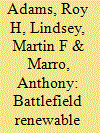

|
|
|
| 5 |
ID:
137832
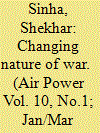

|
|
|
| 6 |
ID:
145053


|
|
|
|
|
| Summary/Abstract |
This article examines the impacts that the embrace of diversity talk has had on identity and ethnic politics in Turkey that has evolved toward a relative and selective recognition. Based on the analysis of the cases of the Laze and Kurdish movements, the article argues that the politics of recognition are built conjointly by an array of actors, at different levels, with different aims, and through their very practices and interactions. The article shows that, although the embrace of diversity talk may mark a depolitization of the ethnonational claims, it still gives room to forms of resistance. These dynamics have shaped a noncoherent, multilayered recognition that does not allow the building of a common ground in the country but rather of a battlefield around discursive and policies choices.
|
|
|
|
|
|
|
|
|
|
|
|
|
|
|
|
| 7 |
ID:
130689
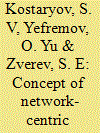

|
|
|
|
|
| Publication |
2014.
|
| Summary/Abstract |
The article discusses the U.S. commands' views on the significance of human factor in the battlefield as set out in the Joint Vision 2020 doctrine. Topics discussed include the high value on information in U.S. documents on military policy and warfare, role of high-tech weapons and information systems in military conflicts and the imperfections of technology. It also mentions the importance of effective leadership in contemporary system for educating and training of U.S. servicemen
|
|
|
|
|
|
|
|
|
|
|
|
|
|
|
|
| 8 |
ID:
130140


|
|
|
|
|
| Publication |
2013.
|
| Summary/Abstract |
OEMs (Original Equipment Manufacturers) increasingly outsource (part of) their supply chains to contract manufacturers. Various benefits, reasons, risks, and theories on outsourcing have been developed, discussed, and analysed in a wide body of literature. This article focuses on supporting national Armed Forces on and off the battlefield.
|
|
|
|
|
|
|
|
|
|
|
|
|
|
|
|
| 9 |
ID:
087821
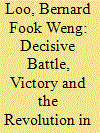

|
|
|
|
|
| Publication |
2009.
|
| Summary/Abstract |
This article examines the notion of so-called decisive victory, and the apparent relationship between battlefield victory and strategic success. It argues that there is no necessary causal relationship between what happens on the battlefield and the eventual outcomes of wars. It further argues that the Revolution in Military Affairs, because it appears to render battlefield success so much more attainable, further complicates muddled strategic thinking on these issues, and may actually be counter-productive to strategic success.
|
|
|
|
|
|
|
|
|
|
|
|
|
|
|
|
| 10 |
ID:
102230
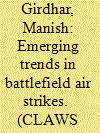

|
|
|
| 11 |
ID:
066310
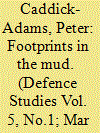

|
|
|
| 12 |
ID:
147535
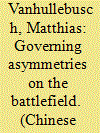

|
|
|
|
|
| Summary/Abstract |
Governing contemporary warfare is deeply rooted in the shift since the end of the Cold War towards humanitarianism, whose practice has been accompanied by the parallel evolution of international laws that regulate the use of force (jus ad bellum), the conduct of hostilities (jus in bello), and post-conflict justice (jus post bellum). Yet, new unequal obligations on behalf of the territorial state faced with proxy warfare internally and foreign intervention externally have challenged the core role of such governance, and led to further erosion of the normativity of those rules in the theatres of conflict. As a result, this rule-based approach to government falls short of restoring the actual relationships and human ties between the warring parties. The undesired outcome of such humanitarian ambitions can be mediated through relational governance, as espoused by Yaqing Qin, one of China’s leading international relations scholars, which is founded in a Chinese epistemological and relation-focused framework. Its tools and methods stress the importance of trust and harmonization of relationships, in order for the international laws governing warfare to regain their normativity based on such relationality; without a fertile soil, evolving norms may not gain root and compliance with those norms cannot be fostered in the first place.
|
|
|
|
|
|
|
|
|
|
|
|
|
|
|
|
| 13 |
ID:
129715
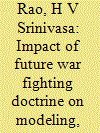

|
|
|
| 14 |
ID:
121648
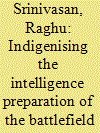

|
|
|
| 15 |
ID:
130144
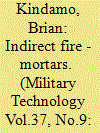

|
|
|
|
|
| Publication |
2013.
|
| Summary/Abstract |
The indirect fire infantryman is a member of mortar squads, sections or platoons. The mortar has the most power and range of any weapon in the infantry unit when they are out on the battlefield.
|
|
|
|
|
|
|
|
|
|
|
|
|
|
|
|
| 16 |
ID:
130109


|
|
|
|
|
| Publication |
2014.
|
| Summary/Abstract |
So many sensors now populate the battlefield that there is almost no portion of the electromagnetic spectrum unexploited by imaging devices operating in the visual, near IR, short, medium and long wave IR, and even ultraviolet wavebands. IR sensors, however, are now so widespread that managing thermal signatures has become as important as visual camouflage. As with stealth at sea and in the air, however, benefits are generally analogue rather than digital - people and things are not either visible or invisible, rather they are more or less visible at varying ranges. This means that small improvements in signature management can give the side that possesses them a significant advantage.
|
|
|
|
|
|
|
|
|
|
|
|
|
|
|
|
| 17 |
ID:
147082
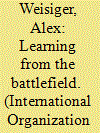

|
|
|
|
|
| Summary/Abstract |
What drives leaders’ decisions about whether to continue or end an ongoing war? The private information explanation for war holds that leaders fight because they believe that doing so will advance national interests, and they settle hostilities when new information reduces their optimism about the possibility of long-term success. Yet significant theoretical disagreement exists about both the extent to which and the manner in which new information, especially battlefield information, promotes settlement. This article unpacks the logic of the informational mechanism, arguing that settlement will be more likely when there has been more extensive fighting and that countries are more likely to make concessions to end wars when battlefield results have deteriorated; short-term spikes in war intensity by contrast do not promote settlement. Moreover, building on work on leadership turnover and settlement, I show that leader replacement is sometimes part of the information-updating process, especially in autocracies: new leaders without political ties to the person in power at the start of the war are more likely both to come to power when war is going poorly and to end wars once in office. Tests of these arguments make use of new participant-level data on the timing of battle deaths for all Correlates of War interstate wars, which allows me to examine the effects of changing battlefield developments across a wide range of cases in a manner that was previously impossible.
|
|
|
|
|
|
|
|
|
|
|
|
|
|
|
|
| 18 |
ID:
105349
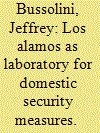

|
|
|
|
|
| Publication |
2011.
|
| Summary/Abstract |
Much of the strategic analysis, geographic knowledge/ignorance, and military-security emphasis of post-September 11th America bore a striking resemblance to Los Alamos of the 1980s. After briefly considering the foreign-policy aspects of the work at Los Alamos and some theoretical, historical, and state aspects of the nuclear age that define the domestic space and the population as targets, I focus on the many ways in which the Laboratory has served as a site of development for domestic security measures. In some cases it is the community of Los Alamos at large which seems to be the template for the measures, inasmuch as this is a town adjoining and surrounding the Laboratory. One of the main thrusts of the argument here is that the division between 'foreign' and 'domestic' in contemporary intelligence and military strategy is specious.
|
|
|
|
|
|
|
|
|
|
|
|
|
|
|
|
| 19 |
ID:
027421
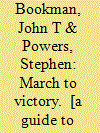

|
|
|
|
|
| Publication |
Cambridge, Harper and Row, Publishers, 1986.
|
| Description |
xi, 340p.Hbk
|
| Standard Number |
006015506X
|
|
|
|
|
|
|
|
|
|
|
|
Copies: C:1/I:0,R:0,Q:0
Circulation
| Accession# | Call# | Current Location | Status | Policy | Location |
| 027189 | 914.04558/BOO 027189 | Main | On Shelf | General | |
|
|
|
|
| 20 |
ID:
125966
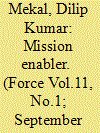

|
|
|
|
|
| Publication |
2013.
|
| Summary/Abstract |
An exclusive invitation to visit the Lincoln facility of UK-based Selex ES, for an in-depth experience at their Electronic Warfare Operational Support (EWOS) offerings, provided an excellent opportunity to get a closer look at EWOS and the crucial role it plays in today's battlefield. Over a packed day full of briefings on EWOS, this correspondent was taken through the entire spectrum of EWOS, starting from the various products and tools used to analysis and testing of the mission data file using hardware-in-the-loop simulators.
|
|
|
|
|
|
|
|
|
|
|
|
|
|
|
|
|
|
|
|
|